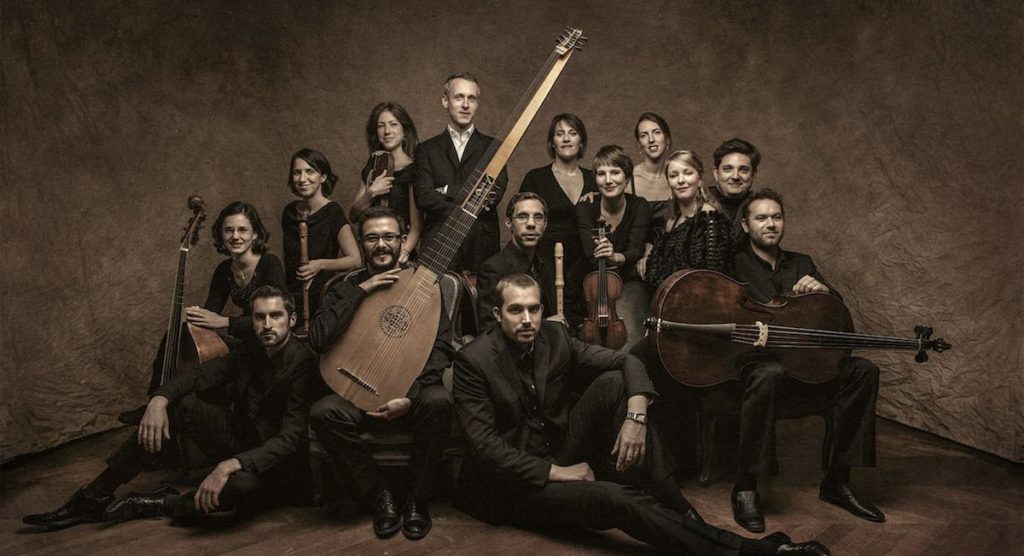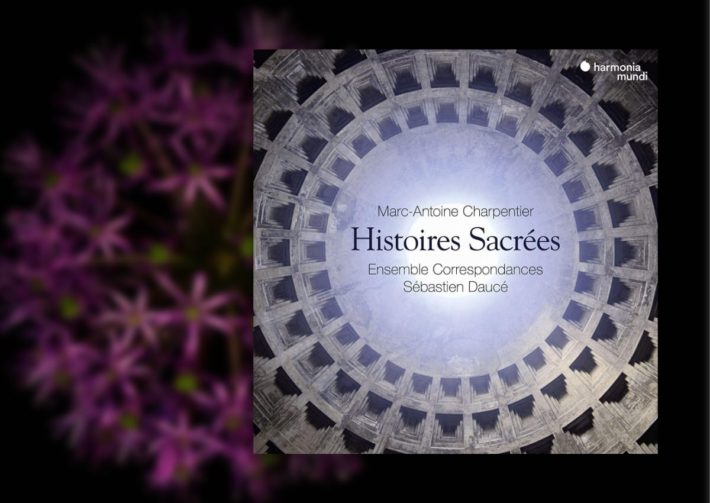In their latest release, Ensemble Correspondances and their director Sébastien Daucé continue to champion the music of Marc-Antoine Charpentier, one of the most sophisticated composers of the French Baroque. Charpentier’s impressive œuvre of sacred music contains numerous works for devotional services.

The title of this album focuses on “Histoires sacrées”, essentially a truncated hybrid of opera and oratorio. The informative booklet points out that ‘histoires sacrées’ is not a term used by Charpentier, but a wider description for works with a dramatic narrative based on biblical subjects. Cast in Italianate forms and setting non-biblical Latin texts, these works employ small instrumental forces with a range of voices and choirs. Why these pieces were commissioned and by whom is not clear, yet it’s certain these are highly imaginative and harmonically intriguing compositions, still unduly underperformed.
Ensemble Correspondances presents three histoires sacrées — “Cæcilia, virgo et martyr octo vocibus” H. 397, “Judith, sive Bethulia liberata” H. 391 and “Mors Saülis et Jonathæ” H. 403, along with a selection of shorter companion works. The consistent sense of style in these pieces is remarkable. Throughout, one is struck by the rhythmic vitality — seemingly inspired by dance. The tempo choices make this music vibrantly energetic, as both of the “præludiums” in “Cæcilia” exemplify (tracks 1 & 5, disc 1).
“Mors Saülis et Jonathæ”, which opens the second CD, is the indisputable highlight of the album, with its instrumental richness and innovative vocal writing. This substantial piece of approximately 35 minutes allows Ensemble Correspondances to delve deeper into the operatic nature of the work, aptly demonstrated in “Age cito” (track 9). This brims with drama and strong storytelling. Switching between vocal solos and tuttis (where soloists make for a one-per-part choir), the singing has a natural sense of spontaneity, making it utterly captivating.
The music is treating with much care and attention; the phrasing natural and subtle changes in dynamics add interest. The assured usage of French Latin further ensures the sophisticated level of detail, authenticity and authority. Ornamentation is used to enhance the direction of the phrases but without hindering the melodic line. These are executed accurately by each singer; never overdone, ever tasteful and stylistic, the voices blending in sheer beauty. The level of musicianship and virtuosity is never extravagant but elegantly restrained. Taste from the ensemble’s performance in “Judith” (track 15, disc 1) or the concluding section of “Cæcilia” (track 10, disc 1) to experience how exquisite the unity of the singing is.
The continuo in Baroque music can become monotonous and texturally dull. Here, Ensemble Correspondances’ continuo is instrumentally rich, with organ, harpsichord, theorbo and viola de gamba. Each of the “Histoires Sacrées” is differentiated by its choice of continuo instruments, hence making them clearly distinctive from each other. And so in “Cæcilia”, the section assigned to the narrator (Davy Cornillot) allows the singer to use subtle changes of tone to emphasize particular words, intensifying the meaning of the text (track 6, disc 1). Another outstanding example is “Surge Saül et responde mihi!” in “Mors Saülis et Jonathæ” (track 6, disc 2) in which the choice of organ stops adds to the drama.

Superbly recorded to Harmonia Mundi’s high standards during late 2016 in MC2 Grenoble and Maison de la Culture, Amiens, the engineering is such that the difference in recording venue is indistinguishable. The engineers have blended the voices judiciously with an intuitive understanding of the music. Each soloist is separated accordingly from each other, giving the listener a sense of space and theatricality. The balance of the continuo never intrudes. The harpsichord, for instance, is intermixed with sufficient distance to prevent dominance, but close enough for the nuances to be discernible. Full texts and translations are included, along with details on the performing editions for scholarly interest.
A treasure of a release, essential for those with an interest in Baroque sacred music or opera. With their instinctive sense of style, it would be interesting to see how Ensemble Correspondances tackle larger scale pieces such as Monteverdi’s “Orfeo” or Purcell’s theatre music. If not already acquired, their other releases come highly recommended.
Charpentier – Histoires Sacrées:
“Cæcilia, virgo et martyr octo vocibus” H. 397
“Judith, sive Bethulia liberata” H. 391
“Mors Saülis et Jonathæ” H. 403
Additional vocal and instrumental works
Ensemble Correspondances
Sébastien Daucé – Conductor
Harmonia Mundi, 2 CDs + Bonus DVD, 902280.81




















